Have you spotted any signs of rust on your Blackstone griddle? No need to worry, you can save your griddle top! Whether you own a Blackstone or another brand of griddle we’re here to guide you through how to clean a rusty griddle, and what to do to keep the rust from coming back!
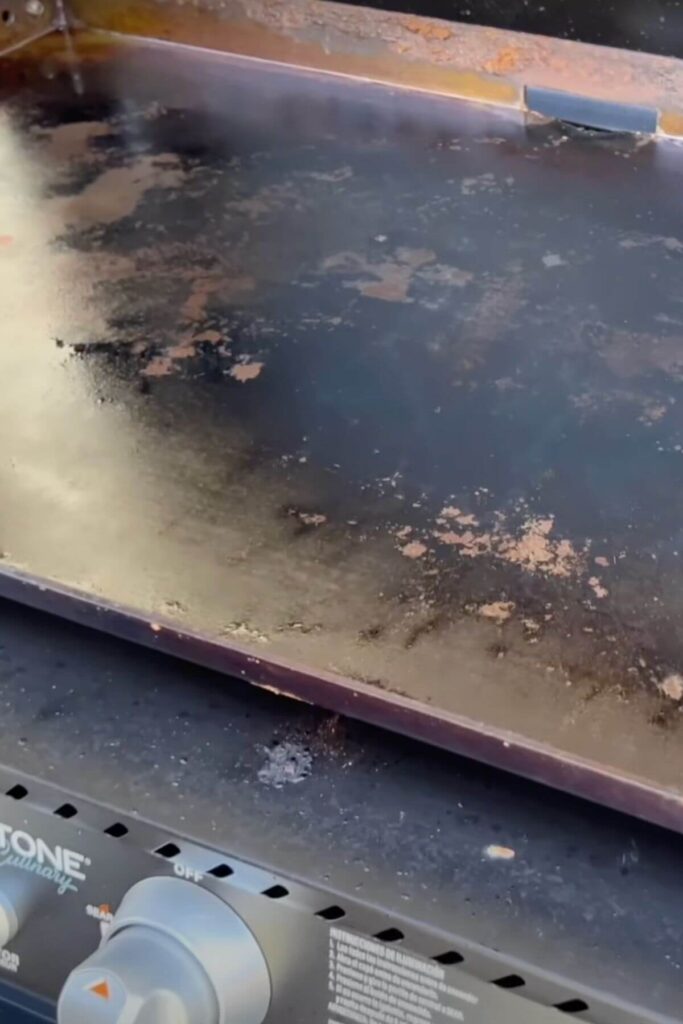
One of the most popular questions that we get in the comments section of our griddle cooking YouTube channel is “How do I clean rust off my griddle top?”.
Uncovering your flat top grill or griddle and finding a rusty surface can stir up feelings of panic, or downright anger because you worked so hard to season the griddle in the first place! But before you throw in the towel and list that hunk-o-junk on the online marketplace, just know that rust is a common problem with outdoor griddles.
And the good news is, you can fix it!
With this helpful guide and the appropriate griddle cleaning tools, you can restore your Blackstone griddle or other flat top grill to its original state and get back to griddling up some amazing meals!
In this article, we’ll take you through the step-by-step process of removing rust from a Blackstone griddle and provide some advice on preventing that pesky rust from returning.
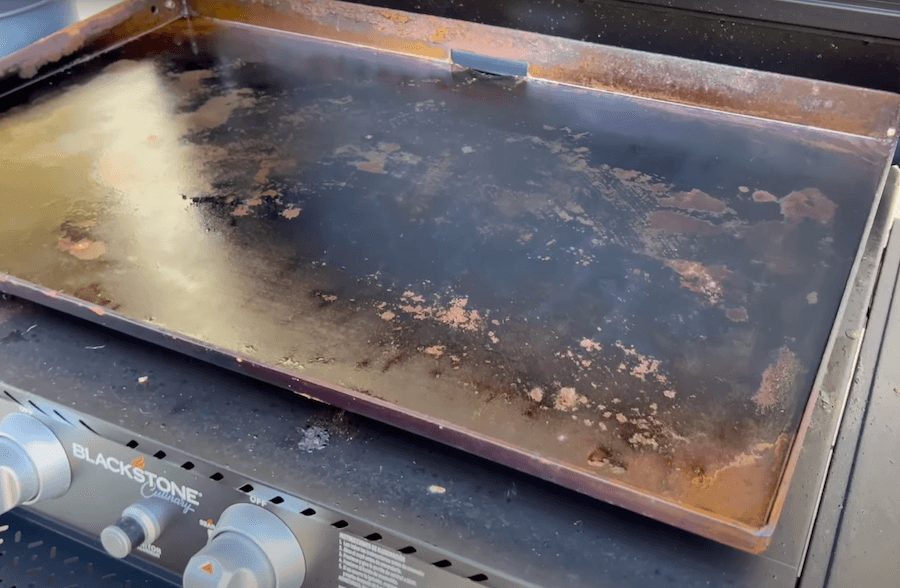
What Causes an Outdoor Griddle to Rust
You’ve seasoned your Blackstone griddle following the manufacturers guidelines (right?!). Somehow rust has still managed to make an appearance. How did that happen?
There are a couple of reasons why even a well-seasoned griddle might start to rust:
- Exposure to moisture – Living in an area with high humidity or not properly drying your griddle after cleaning can result in rust forming quickly. Remember, water and steel don’t mix.
- Infrequent use – If you don’t use your griddle regularly the protective seasoning layer can deteriorate, making the surface more prone to rust. It’s like the old saying goes, “use it or lose it!”. *This was the case when I fixed my brother-in-law’s rusty Blackstone griddle – you can watch that video on our YouTube channel here.
- Poor storage – Leaving your griddle outside without a cover or in a place where it will get wet is an open invitation for rust. Your griddle needs a safe storage spot when not in use.
- Scratches or damage – If the seasoning layer is scratched or damaged, it exposes the steel underneath which is more likely to rust. Treat your griddle with care!
Supplies Needed
Now that we’ve identified what causes rust, let’s discuss the tools needed to remove it from your Blackstone griddle. To clean a griddle you’ll need these basic griddle accessories:
- Scraper –
If you own a griddle, having a scraper is essential for removing food particles and fighting rust. A good quality metal scraper, also known as a bench scraper, can effectively remove rust and debris from the griddle’s surface.
- Squirt Bottle –
Fill a squirt bottle with water to create steam that helps loosen debris on the griddle’s cooking surface during cleaning. You can easily find one at your dollar or big box store.
- Heat-protectant Gloves –
Safety should always be a priority when dealing with a hot griddle. Using heat-proof gloves can help shield your hands from burns. Look for gloves designed to withstand high temperatures that offer a grip and are easy to maneuver in. Silicone gloves are a good choice due to their durability and easy maintenance.

- Grill Brick –
A grill brick acts like a pumice stone for your griddle aiding in sanding down rust spots and restoring the surface to its smoothness. It’s particularly useful for addressing rust buildup issues. You can find an in-depth article on how to use a grill brick on your griddle here.
- Seasoning Oil and Paper Towels –
Once you’ve successfully removed all the rust from your griddle, it’s crucial to re-season it to prevent future damage to the surface. You will need a good high smoke point oil and paper towels for this. I personally use and recommend avocado oil or grapeseed oil.
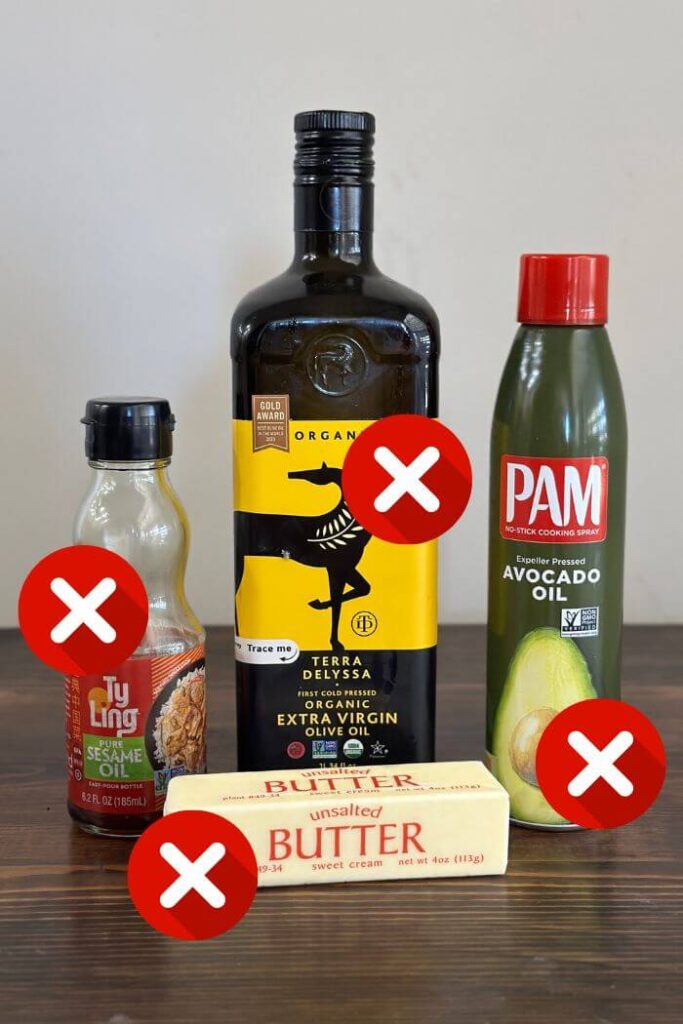
Be sure to check out this guide on the best griddle seasoning oil to see my favorite options and the oils that I definitely DON’T recommend for seasoning!
How to Clean a Rusty Griddle
Now that you have all your tools ready it’s time to get started. Here’s how you can get rid of rust from your Blackstone griddle and bring its surface back to life:
Step 1: Warm up your griddle
Begin by turning on your griddle to a low heat setting and letting it reach a temperature of about 300-325°F. This will help loosen any rust that’s stuck on the surface and make it simpler to clean. The heat will also help burn off any leftover oil or debris on the griddle top.
While it warms up be sure to put on some heat-proof gloves for safety.
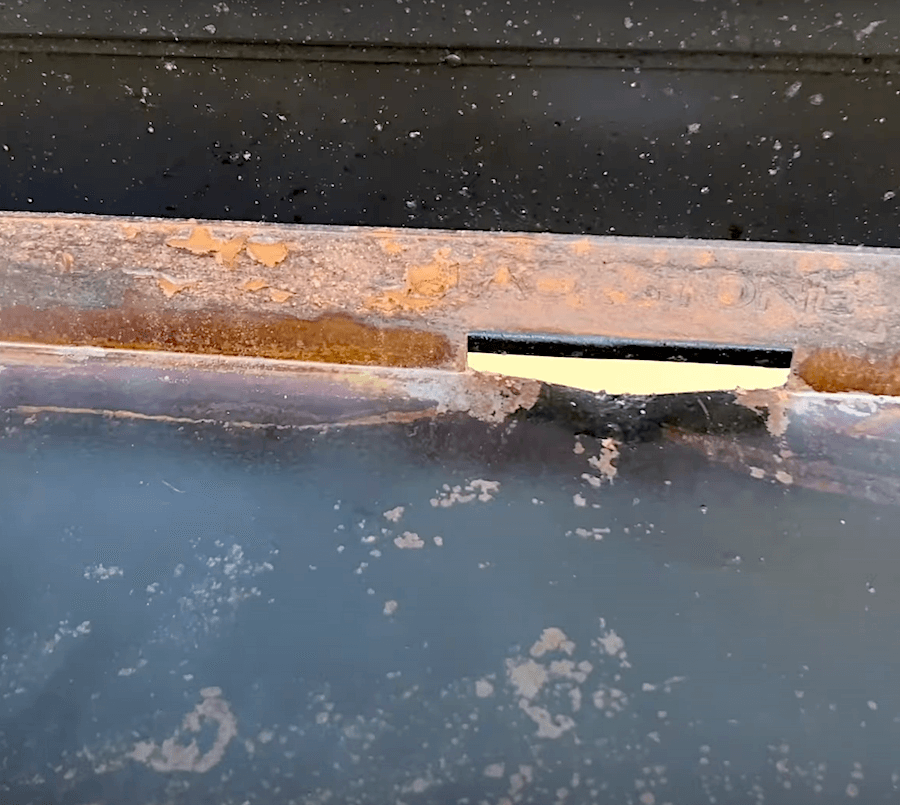
Step 2: Use a scraper to remove any loose rust
Once your griddle reaches about 300-325°F, add a few squirts of water to the warm surface. This will create steam which will help to loosen any rust and debris.
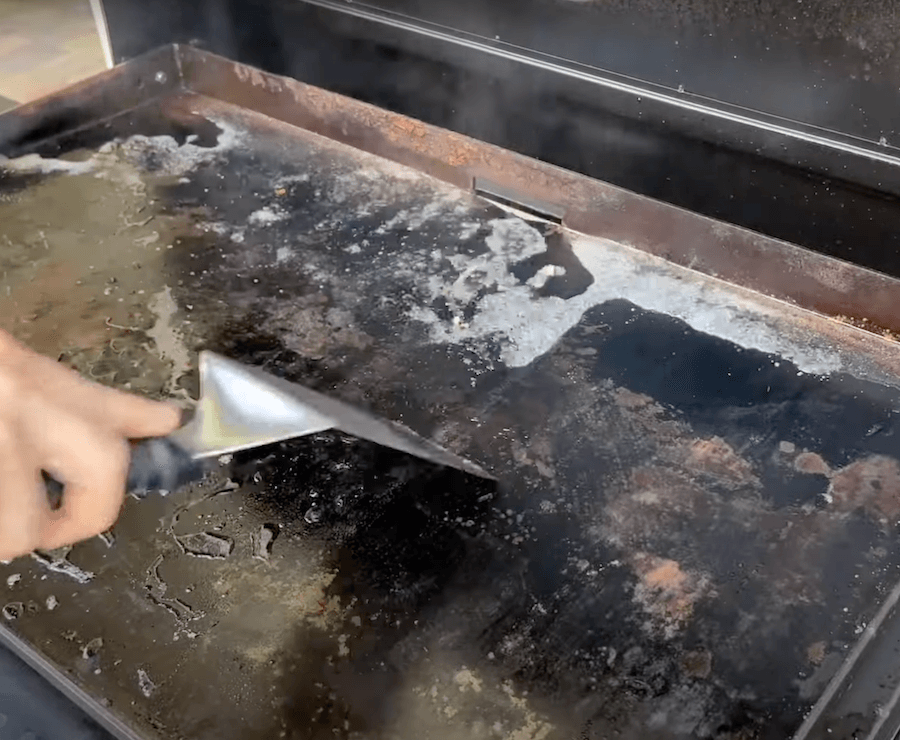
Use light to medium pressure with the bench scraper to gently scrape off the loose rust and water, directing it towards the grease tray. *TIP – Be sure that your grease tray is empty before starting this process, as it will fill up quickly with the excess water and gunk.
Work with small areas at a time, adding a bit of water and scraping down the griddle surface in that area. Then move on to the next area. If you encounter rust that won’t come off easily, don’t scrape too hard. We’ll address those areas in the step.
Step 3: Use a grill brick
*For this step you want the griddle warm – but not hot and not cold. The grill brick will absorb grease and if the oil is too hot – then you’ll burn your hands. Make sure the griddle is off.
For more stubborn rust spots, it’s time to bring in the big guns. A grill brick (sometimes called a pumice grill stone) is an abrasive block that will help you “sand down” the rust and restore your griddle surface to its former glory.
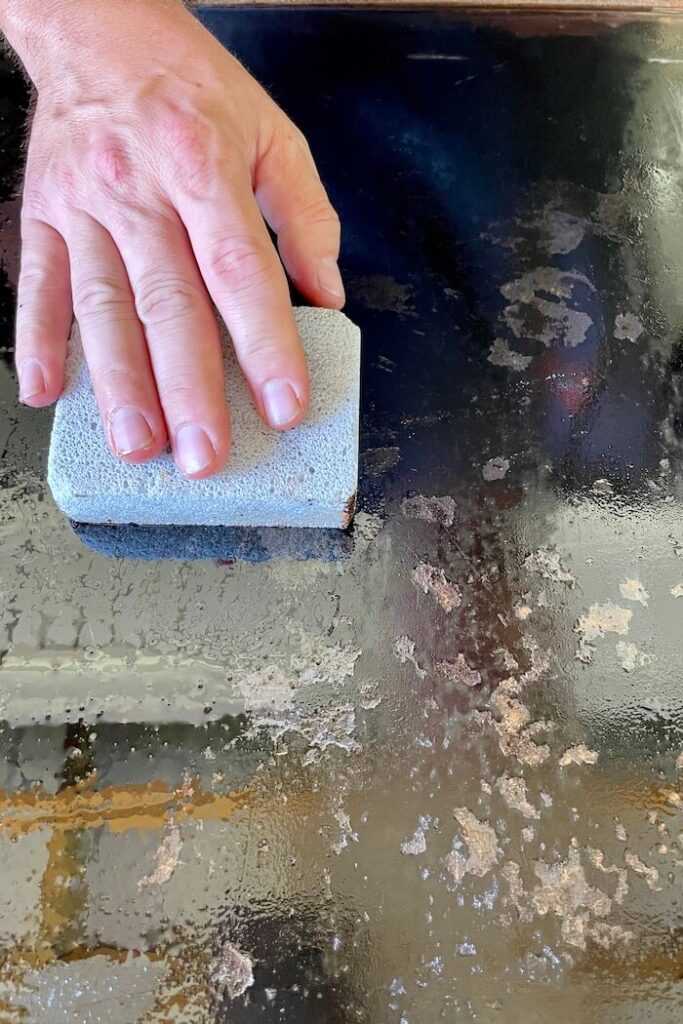
First apply a thin coat of oil to the griddle top to lubricate it and to make using the grill brick easier. Then, gently rub the grill brick over the rusty areas in a circular motion. Apply light pressure and let the grill brick do the work. You might need to go over areas a couple of times to completely get rid of the rust.
For details on how to use a grill brick effectively and when it’s best to use one, take a look at our comprehensive guide.
Step 4: Wipe down the griddle surface
After you’ve scraped off all the rust and sanded down any rough or pitted spots, it’s time for a wipe down of your griddle.
Use a paper towel or a clean cloth along with soapy water to remove any rust debris or dust left behind. Be sure to get into all the nooks and crannies, including the entire cooking surface, the sides, and the back of the griddle.
If you spot any remaining rust patches or areas that are not completely smooth, go back over them with a scraper or grill brick until they disappear.
After clearing all debris from the flat top grill, give it another wipe down with clean water to get rid of any soap residue left behind.
Step 5: Re-season your griddle
Great work on removing all the rust from your Blackstone griddle! However, your job isn’t finished yet. To safeguard your griddle against rust issues and ensure a nonstick surface next time, you’ll need to re-season it.
This process involves applying a very thin coat of high-heat cooking oil onto the surface of the griddle and heating it until it burns off. Repeat this procedure several times (as many as 4-6 times) to establish a protective layer.
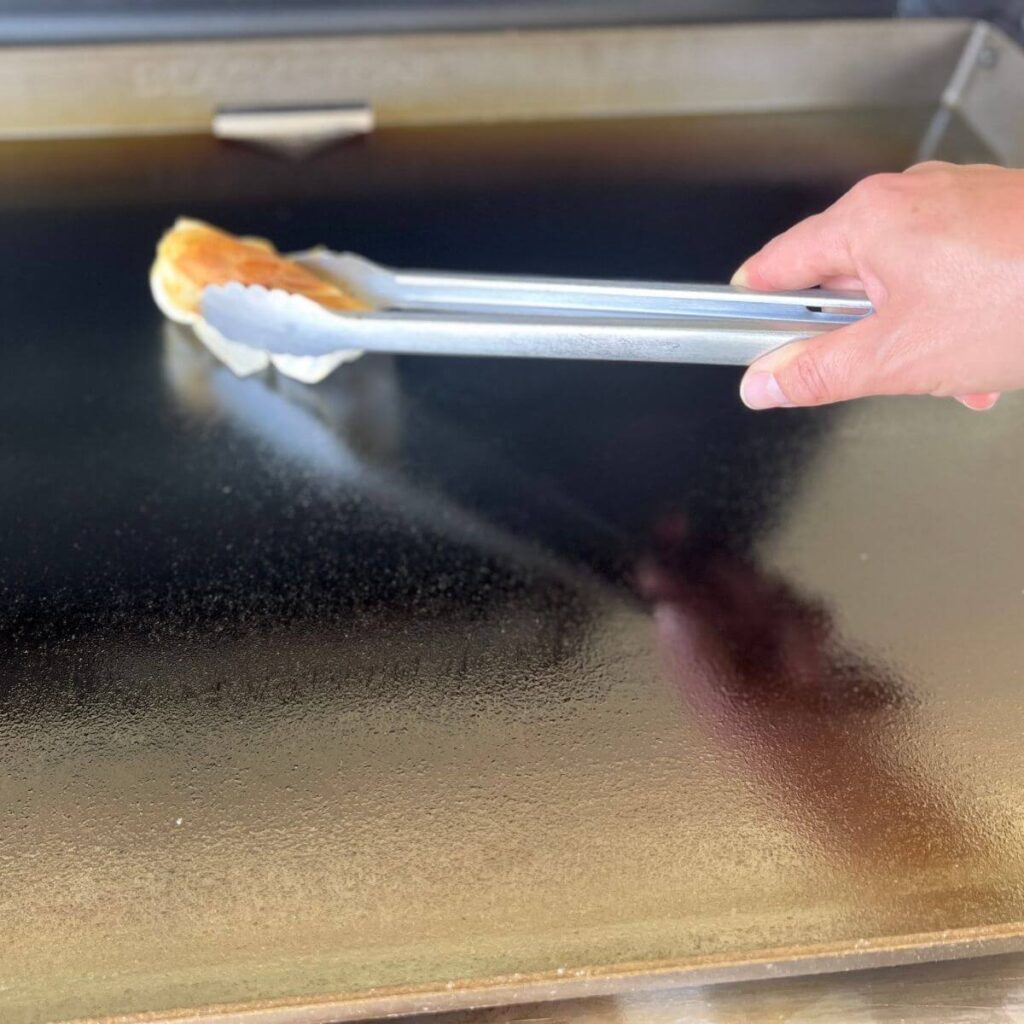
Here’s a brief summary of the griddle seasoning process:
- Turn the griddle on and allow it to heat up for about 10 minutes. Most griddle manufacturers recommend that you turn the griddle on high and preheat for 10-15 minutes, but this can vary by brand so be sure to check your owner’s manual for seasoning instructions.
- Use a paper towel or lint-free cloth to apply a very thin layer of seasoning oil across the entire griddle surface, including the inside and outside of the outer edges.
- Allow the oil to smoke and burn off for about 8-10 minutes. You will notice a large amount of smoke when you first apply the oil, but after several minutes the smoke amount will lessen drastically and the griddle top will appear dry and matte – that’s your indication that it’s time to apply the next layer of oil.
- Repeat steps 2 and 3, applying a thin coat of oil and allowing it to smoke and burn off each time before applying the next layer of oil. Depending on how bad your griddle surface was rusted and how much buffing you had to do with the grill brick, you may need to apply up to 5 or 6 layers of seasoning oil.
For a more in-depth tutorial and tips on seasoning a Blackstone griddle, check out our full guide.
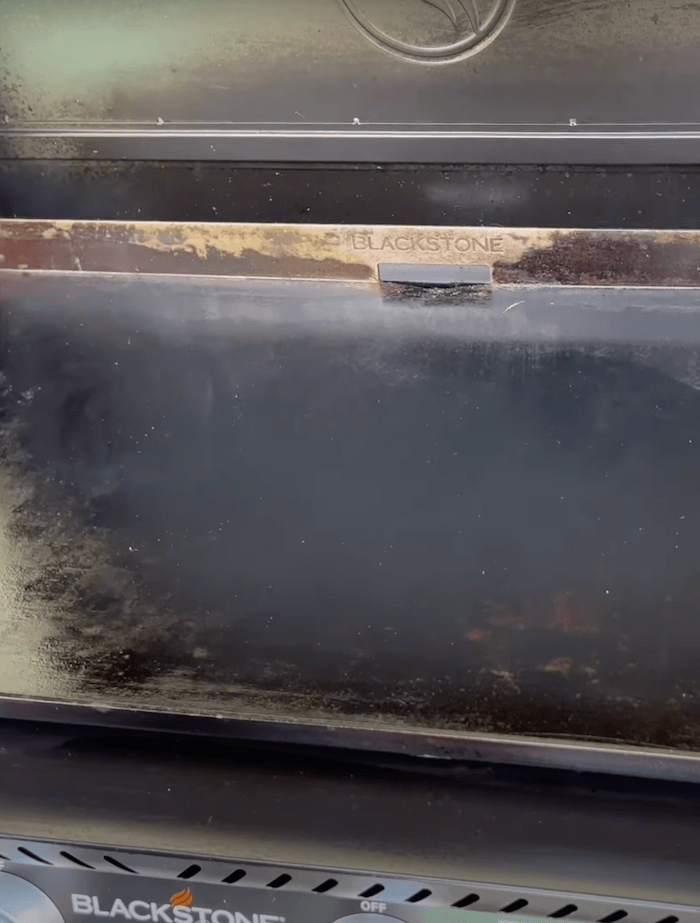
And when you’re done, your griddle top should look something like this – smooth and dark and ready to cook on once again!
*NOTE – Any lighter areas or areas that appear to be discolored will gradually darken over time with repeated use. If your griddle top is rust-free and your food doesn’t stick to the surface while cooking, you’re good to go!
Can you cook on a rusty griddle?
The simple answer is no. Rust is not safe for consumption, and it can impact the flavor of your food while also posing health risks. If you spot rust on your griddle, address it promptly to prevent it from spreading.
How can you prevent your griddle from rusting again?
After you’ve finished cleaning and re-seasoning your Blackstone griddle, it’s important to take steps to keep rust at bay. Here are some tips to help maintain your griddle condition:
- Seasoning Maintenance – Seasoning your griddle acts as a shield against rust and corrosion. It’s recommended to season the griddle every few months (especially if you don’t use it frequently) or when the seasoning wears thin. Refer to our guide for instructions on how to season your Blackstone griddle.
- Regular Cleanup – A key way to prevent rust is by cleaning the griddle after each use. While it’s still warm, scrape off any food residue or grease with a scraper then wipe the surface with a paper towel or cloth. Then apply a thin coat of oil to help protect the surface and prevent moisture buildup.
- Proper Storage – When not in use store the griddle in a covered area, like a garage or shed. If outdoor storage is necessary, consider investing in a high quality cover to shield it from the elements. Before you put it away, ensure that your griddle has cooled down completely and is dry. Apply a coat of oil on the surface to prevent rusting.
- Steer clear of cleansers – When it comes to cleaning your griddle, steer away from using detergents or rough sponges that could harm the seasoning and expose the bare steel to moisture. Stick to gently scraping and wiping the surface with a cloth or paper towel.
*Pinterest User? Do me a favor and PIN this to your griddle cooking board on Pinterest… This is a great way that you can support us!
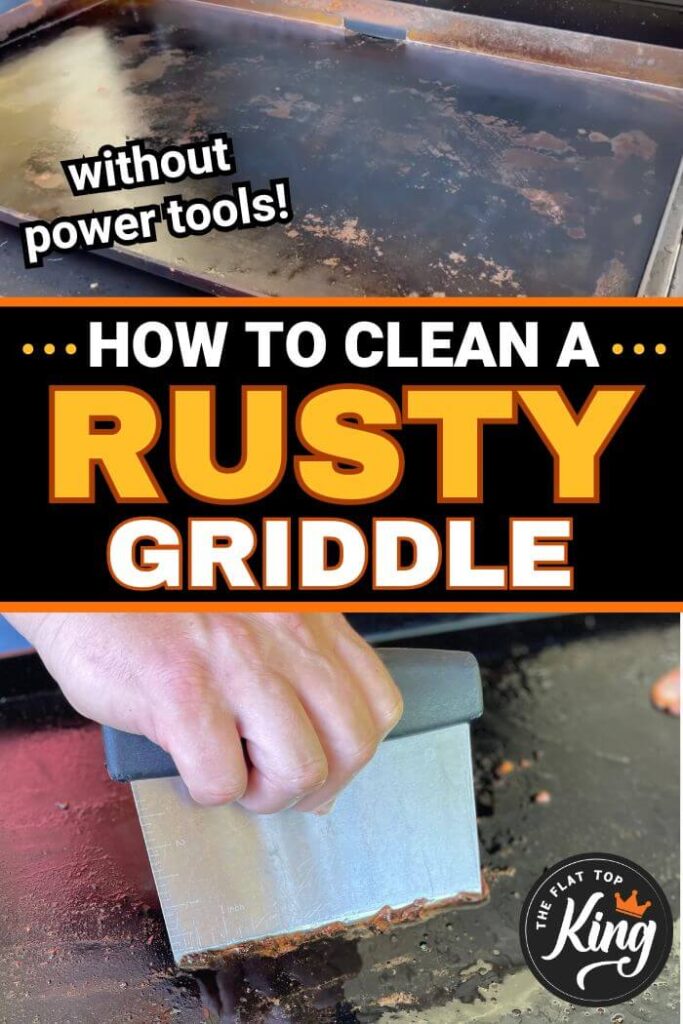


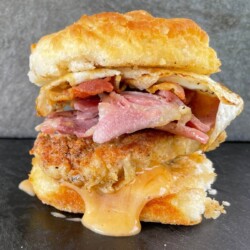
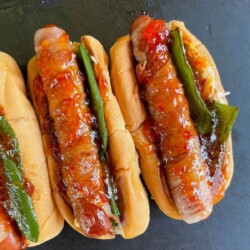




Get More Griddle Recipes!
Follow The Flat Top King on YouTube for more recipes and tips for mastering your griddle!
Subscribe Now